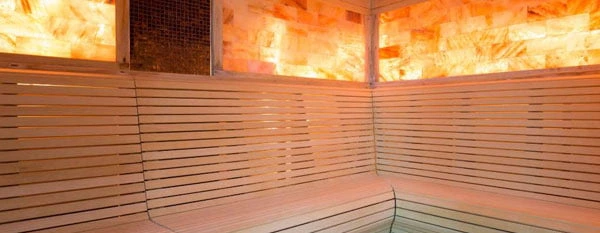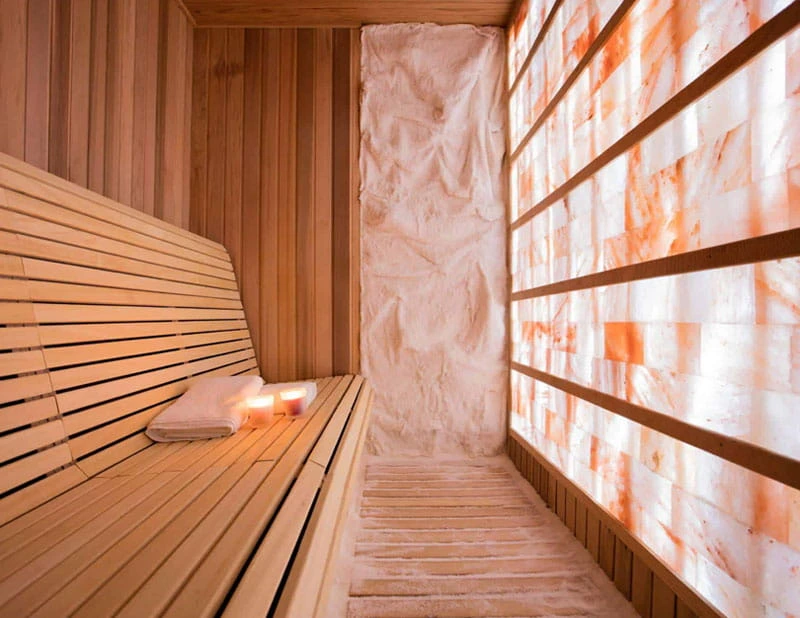With the growing interest in alternative wellness remedies and therapies, salt rooms have become increasingly popular in recent years. A salt room is a controlled environment designed to replicate the natural climate of salt caves. These rooms are believed to provide numerous health benefits, particularly for those suffering from respiratory and skin conditions.
The environment in a Salt Room is intended to provide a therapy called Halotherapy which involves breathing micro-particles of salt and sometimes being exposed to small amounts of salt on the skin. This is believed by some to promote respiratory and skin health.
As word about these unique spaces spreads, many people are beginning to wonder if it’s possible to create a salt room within the comfort of their own home. Building a salt room at home can be an attainable goal for those who want to experience the purported advantages of halotherapy without needing to visit a commercial facility. It’s important to consider factors such as adequate space, proper ventilation, and the type of salt to be used.
When planning the construction of a home salt room, it’s essential to understand the different elements that make up these therapeutic spaces. Investing time and effort in research and planning will help ensure the project’s success and provide the desired health benefits right in the comforts of one’s own home.

What Is A Salt Room
A salt room is a specially designed space that replicates the environment of a natural salt cave. It consists of multiple layers of salt on the walls and floor, typically using Himalayan salt or other therapeutic salts.
Halotherapy is inspired by the centuries-old practice of salt mining and the observation that salt miners experienced fewer respiratory issues than other individuals. Salt rooms recreate the natural environment of salt mines, providing a controlled and relaxing space for halotherapy sessions. The walls and floor of the salt room are covered with salt, either in the form of loose granules, blocks, or panels. We’ve dedicated an article to Halotherapy benefits, so if you’d like to review that information, please see Halotherapy: Revealing Its Health Benefits and Uses.
Modern salt rooms are equipped with a halogenerator, a device that disperses a fine mist of micronized salt particles into the air, further enhancing the therapeutic experience.
Salt therapy has numerous reported benefits, including relief of respiratory symptoms and improvement in skin conditions such as eczema and psoriasis. The negative ions released from the salt create a calming environment, providing an atmosphere conducive to stress relief and relaxation.
While traditional salt caves are naturally occurring, salt rooms can be found in spas and wellness centers across the globe. Some examples of salt therapy centers are those featuring Himalayan salt, boasting its unique pink hue and mineral-rich properties. Among the variety of salt rooms available, each one offers a serene and soothing environment for individuals seeking the benefits of halotherapy.
Benefits Of Salt Therapy
Salt therapy, also known as halotherapy, offers numerous health benefits for a variety of conditions, particularly for respiratory and skin issues. When exposing the body to the negative ions within a salt room, people often report an improvement in their overall well-being.
Respiratory ailments, such as asthma, bronchitis, and chronic obstructive pulmonary disease (COPD), may significantly benefit from salt therapy. As it clears mucus from the respiratory system, salt therapy may help alleviate inflammation and promote easier breathing. Those suffering from allergies may also experience relief, as salt rooms may reduce airborne allergens and improve lung function.
In addition to respiratory health, salt therapy aficionados cite positive effects on various skin conditions. Eczema, psoriasis, and dermatitis are common issues that can be soothed by spending time in a salt room. The anti-inflammatory properties of salt help reduce redness and itching, while its antibacterial properties may aid in the healing of acne-prone skin.
Individuals with cystic fibrosis may find relief through salt therapy, as it helps to loosen and clear mucus from the lungs, allowing for easier breathing and reduced inflammation. This may also help to reduce the risk of respiratory infections.
History And Popularity
The origin of salt rooms traces back to European salt mines, where salt therapy was first discovered. Dr. Feliks Boczkowski, a Polish physician, observed the workers in these salt mines had better respiratory health than those working in other industries. He attributed this to the healing properties of salt in the air. In the mid-20th century, artificial salt rooms began to gain popularity, first in Europe and then globally.
Over the years, salt room therapy, also known as halotherapy, has gained attention worldwide for its potential benefits to respiratory and skin health. The growing interest in natural and alternative therapies has contributed to its increased popularity.
As the demand for halotherapy increased, spa facilities started offering salt rooms as part of their services. In recent years, the trend of having a salt room at home has also emerged. Homeowners appreciate the convenience and privacy of having access to salt therapy in their own living spaces, as well as having regular access to therapy sessions.
In constructing a salt room at home, there are several key elements to consider. The room needs to be lined with salt bricks or salt panels, and a halogenerator is required to disperse fine salt particles into the air. Also, proper ventilation and temperature control are essential for maintaining the optimal environment for salt therapy.
Comparing Salt Rooms and Salt Caves
Salt rooms and salt caves both provide a unique environment for those seeking the potential health benefits of salt therapy. To understand their differences, let’s delve into their distinct features.
First, let’s take a look at the construction of both types of spaces. Salt rooms, which can be built in your home, typically have walls and ceiling covered in salt blocks or panels made from sodium chloride. Salt caves, on the other hand, are naturally occurring spaces often found in specific geological areas, where the walls and ceiling contain various forms of mineral-rich salts. While salt rooms offer a controlled environment, salt caves provide a more rugged and organic ambiance.
The atmosphere in both salt rooms and salt caves is designed to mimic the environment found in natural salt mines. However, salt rooms often use specialized halogenerators that release tiny salt particles into the air, maintaining precise control over the humidity and particle concentration. In contrast, salt caves rely on the natural humidity and air circulation to distribute salt particles.
One significant difference between salt rooms and salt caves is the experience they provide. Salt rooms often resemble a beach getaway, with salt-covered floors akin to sand and a peaceful atmosphere. In contrast, salt caves have a more rugged aesthetic and often include stalactites hanging from the ceiling and uneven surfaces, offering a unique, natural experience.
Both salt rooms and caves aim to create an environment with therapeutic potential, such as relief for respiratory and skin conditions. Some users report experiencing a sense of relaxation and improved well-being after participating in salt therapy sessions.

Designing and Building A Salt Room
When designing and building a salt room, various factors need to be considered to ensure its efficacy and functionality. One of the key elements is the choice of building materials, mainly salt bricks and Himalayan salt bricks. These bricks are essential in maintaining the desired salt concentrations in the air, contributing to the numerous health benefits.
Choosing the appropriate lighting for a therapy room is also crucial. Soft, warm lighting is recommended to create an ambiance that promotes relaxation and reduces stress. Moreover, ensure the room has proper soundproofing for a tranquil atmosphere. This can be achieved by using insulated construction materials and installing sound-absorbing panels.
Next, consider the ventilation during the design phase. Proper air circulation is required, so installing an efficient ventilation system is essential to maintain air quality and moderate humidity. Regarding heating, choose a system that maintains a stable temperature and evenly distributes warmth throughout the room. The recommended temperature for Halotherapy is 68 degrees Fahrenheit. The flooring should be easy to clean and maintain, such as sealed concrete or floor tiles.
In selecting the location within your home for a salt chamber, consider a dedicated space that provides a sense of privacy and relaxation. Avoid choosing areas next to kitchens or bathrooms, as these spaces may introduce excess moisture.
Salt can be corrosive to metal, so care should be taken to isolate the salt components of your room from any metal items such as fasteners. Salt blocks should held in place by materials that will not react to the salt.
When it comes to furnishing the room, avoid typical furniture with fabrics, as they can collect moisture and negatively impact the salt chamber environment. Instead, opt for materials such as wooden or plastic benches, chairs, and loungers. Another option is to use salt boulders or tiles as seating, giving the room a more authentic and natural feel.
DIY Salt Room
Some people considering building their own Salt Room on a budget might consider looking at DIY Sauna kits as a starting place for creating a salt room.
As shown in some of the photos, some components from a sauna such as the comfortable cedar or hemlock wood bench material may be helpful in your project. The flooring and walls in these kits tend to also be lined with wood or other non-metal materials, so you might use this structure as a starting point for adding salt blocks. You should be sure that there is a ventilation system that is adequate for the room. Note that the heating system from the sauna should NOT be used, as the optimum temperature for salt therapy is considered to be 68 degrees Fahrenheit.
Where to Find Salt Blocks for a DIY Salt Room?
Trying to find a source for enough Himalayan salt blocks can be difficult and pricey. Because I am constantly researching salt products, I came across this (apparently new) product on Amazon as one potential source. I want to stress that I have not ordered this product myself, but given that anyone reading this page might be interested in evaluating sources for a salt wall, I decided to share it. Salt is extremely heavy – make sure when doing DIY salt rooms that there is proper support for the weight of the wall.
150 Pink Himalayan Salt Blocks - each approximately 8 x 4 x 2 inches. At about 5.5 pounds a piece, this shipment calculates out at 825 pounds. This might just be the start of a nice salt wall in a home salt room.
Incorporating Wellness Activities
In addition to simply enjoying the benefits of a salt room, one can enhance their experience by incorporating various wellness activities. These activities can promote relaxation and contribute to overall mental and physical well-being.
Among the popular wellness activities to consider incorporating into your routine are:
- Yoga – Yoga is an excellent activity to practice in a salt room. The combination of salt therapy and yoga can help users deepen their breath and stretch, leading to enhanced relaxation and stress reduction.
- Meditation – Meditating in a salt room can be particularly beneficial, as the calming environment created by the salt can help individuals achieve a focused, tranquil state. This can lead to reduced stress levels and improved mental clarity.
- Massage – Receiving a massage in a salt room can provide a unique and relaxing experience. The salt’s properties can aid in the absorption of massage oils, potentially enhancing the benefits for your skin and muscles.
Home Salt Therapy Options
Home salt therapy has grown in popularity as people seek the benefits of salt rooms without having to visit a spa or wellness center. There are several options available for those looking to create an at-home experience.
Portable salt rooms are one option that can be set up and taken down, making them an appealing choice for many homeowners. They typically include a halogenerator, which is a machine that grinds and disperses salt particles into the air to mimic the environment of a salt cave. These portable rooms can be found online or through the Salt Therapy Association.
- At-Home Salt Room – A more permanent option is a designated space in the house. It usually involves walls and ceilings lined with salt bricks, salt panels, or Himalayan salt blocks. This creates a highly controlled and consistent salt therapy environment.
- Halogenerators – A crucial component of any salt therapy experience, halogenerators are responsible for grinding and dispersing salt particles into the air. They can be purchased separately for use in a dedicated room, or found as part of portable salt room packages. If you’d like to try the benefits of halotherapy on a small scale first, you might start with a Salt Inhaler – a smaller device designed for personal use, rather than infusing an entire room. Read about those here: What Is A Salt Inhaler: Uncovering Its Benefits and Uses.
- Salt Booth – If space and budget considerations make a full salt room impractical, a salt booth might be the perfect alternative. It is a smaller, self-contained unit that provides a concentrated salt therapy experience, requiring less room and, often, less investment.
When considering home salt therapy options, it’s essential to research carefully, consider factors such as budget, space, and desired salt therapy intensity, and consult the Salt Therapy Association for guidance in choosing reputable products and suppliers.
Cost And Implementation
As a rough estimate, the cost to construct a purpose-built salt room would be anywhere from $10,000 to $30,000 or more. Variables such as the size of the room, the materials used, and additional features or equipment included can greatly affect the price.
When considering building a halotherapy room in your home, it is essential to factor in the associated costs and the proper implementation techniques. The price of constructing a room could vary depending on factors such as size, design, and the type of salt used.
Firstly, it is important to determine the budget for the project. This can help in setting a clear limit on the expenses and making informed decisions about materials and design. The primary cost components include the construction of the room itself, the installation of a suitable ventilation system, the salt materials, and any additional features such as lighting or furniture.
The selection of salt is a significant aspect of the planning phase. The two primary salt types used in salt rooms are Himalayan pink salt and Dead Sea salt. Each has its own advantages and pricing, but both are known for their therapeutic properties. Himalayan pink salt is usually more expensive, but provides a visually appealing and relaxing ambiance. On the other hand, Dead Sea salt is slightly more affordable and boasts a higher mineral concentration.
- Himalayan Pink Salt – Known for its visually appealing pink hue and therapeutic properties. Tends to be more expensive.
- Dead Sea Salt – Offers a higher mineral concentration and is slightly more affordable than Himalayan pink salt.
Before starting the construction, proper planning and design are crucial. Ensure that the salt room is built in a suitable location within the home with adequate ventilation and humidity control. It is also essential to consult with professionals who specialize in building construction to ensure that all necessary precautions and building standards are met.
What Contributes to the Cost
Here are some cost considerations to keep in mind:
- Construction and Materials: The construction of the room itself, including walls, flooring, and ceiling, will contribute to the cost. The materials used can vary, but common options include salt bricks, salt panels, or salt-infused plaster.
- Salt Generator and Ventilation System: A salt room typically requires a salt generator or halogenerator to disperse the salt particles into the air. This equipment, along with the necessary ventilation system to circulate the salt-infused air, will add to the overall cost.
- Lighting and Ambiance: Some salt rooms incorporate specialized lighting features to create a calming and therapeutic atmosphere. Depending on your preferences, this could include color therapy lights, fiber optic lighting, or other decorative elements.
- Seating and Accessories: Depending on the purpose of the room, you may want to include seating options such as chairs or benches. Additionally, accessories like salt lamps, salt sculptures, or audio systems for music or guided meditation can be considered, adding to the cost.
- Installation and Professional Fees: If you’re not building the salt room yourself, you may need to hire professionals for the construction, electrical work, or HVAC installation. These costs should also be factored into your budget.
Additional Considerations
For some people, a salt room may offer a calming and soothing environment, which can help in reducing stress levels. However, factors such as comfort, possible side effects, and medical history should be considered. Some potential negatives that you should consider:
- Claustrophobia – individuals with claustrophobia or a fear of confined spaces might not find it comfortable.
- Skin Conditions – Another aspect to consider is the effect of salt therapy on pre-existing medical conditions. Some individuals might experience mild side effects such as itching, rashes, or exacerbation of rosacea after a halotherapy session. While these symptoms are generally temporary and mild, it’s essential to monitor any changes to one’s skin.
- Not A Cure-All – Furthermore, while salt therapy may help relieve sinusitis symptoms, neti pots remain a more effective tool for sinus irrigation. Salt therapy should not replace any prescribed medical treatments, such as bronchodilators or medications for fever, tuberculosis, hypertension, cough, or infections.
Remember that every individual might react differently to salt therapy, so it is crucial to consult a physician before building a salt room in your home or participating in salt therapy, especially if you have any pre-existing medical conditions. Trying out halotherapy at a facility like a Spa first may give you personal experience of whether you feel like adding a room in your home might benefit you.
Home Alternatives to a Salt Room
I highly recommend finding out whether salt therapy is for you before committing to building a salt room, however small or DIY. Alternative first steps can include:
- Try a Salt Inhaler – this is a personal use device that allows you to breathe salt particles through a mouth piece.
- Try a Halogenerator – this is a device that grinds and heats salt, then disperses the salt particles into the air. They are usually designed to work in a small room sized area such as a bathroom or other smaller enclosed area. There is a discussion of dry salt therapy and halogenerators within this article: Halotherapy: Revealing Its Health Benefits and Uses.
Commercial Salt Therapy
Wellness centers and spas have embraced the growing popularity of salt therapy, investing in the construction of salt rooms and caves to provide a unique experience to their clientele.
These establishments often highlight the various health benefits associated with salt therapy, such as alleviating respiratory issues and improving skin conditions. The integration of technology is a significant aspect of marketing these services, with businesses utilizing phones and websites to reach potential customers and create bookings.
Salt cave builders specialize in designing and constructing these dedicated spaces, ensuring a seamless integration of the necessary equipment for optimal operation. It is vital for the rooms to have a dry salt aerosol generator, which consistently releases microscopic salt particles into the air.
Many commercial establishments opt to enhance the ambiance of the salt room by incorporating a sound system and speakers, creating a relaxing environment for clients.








